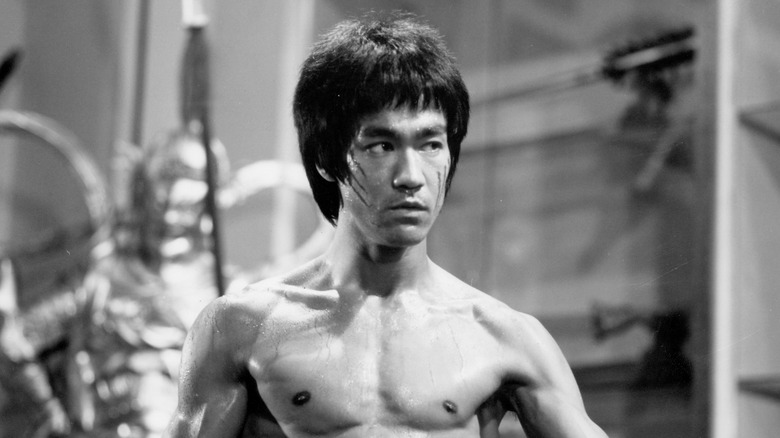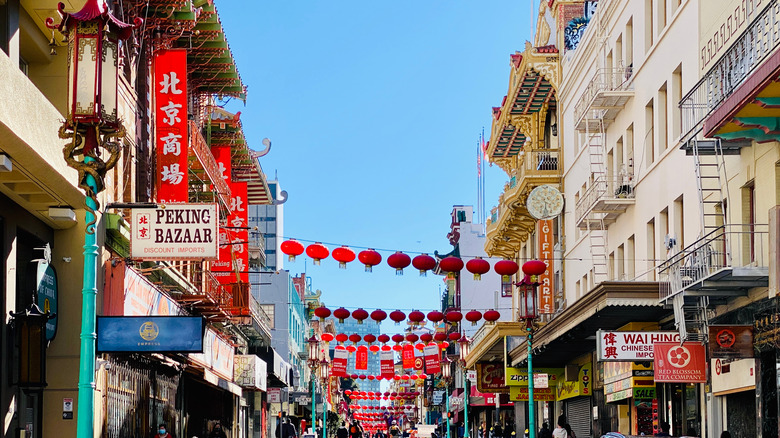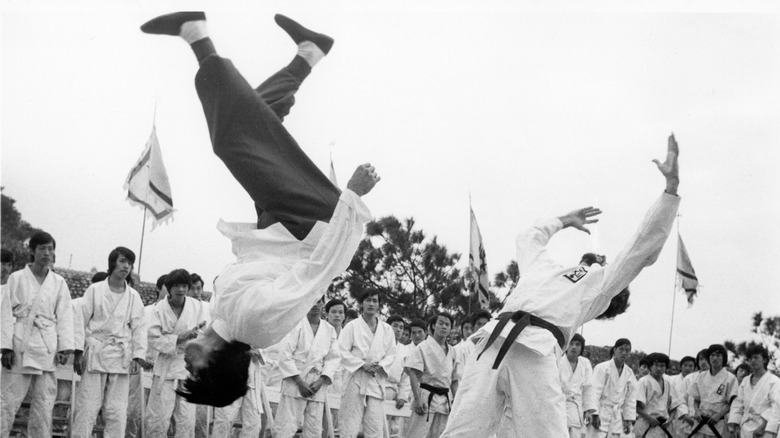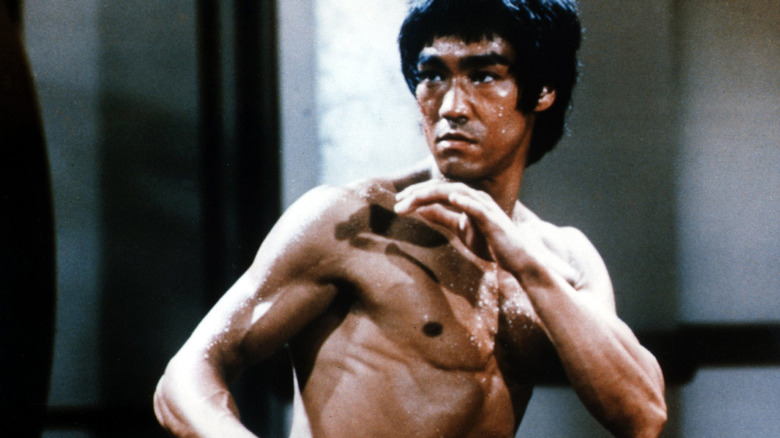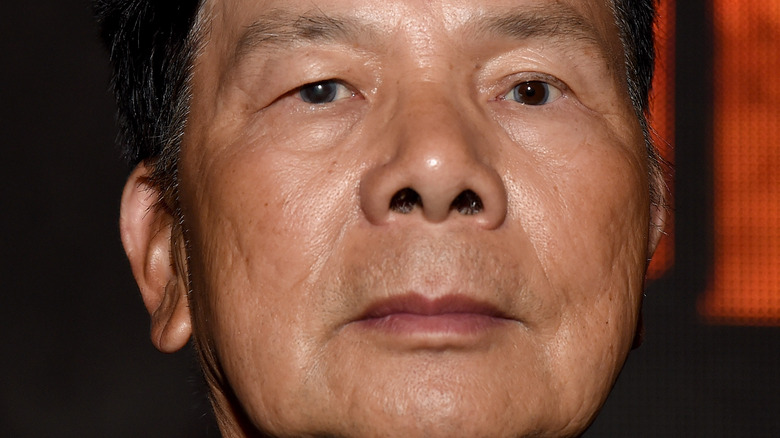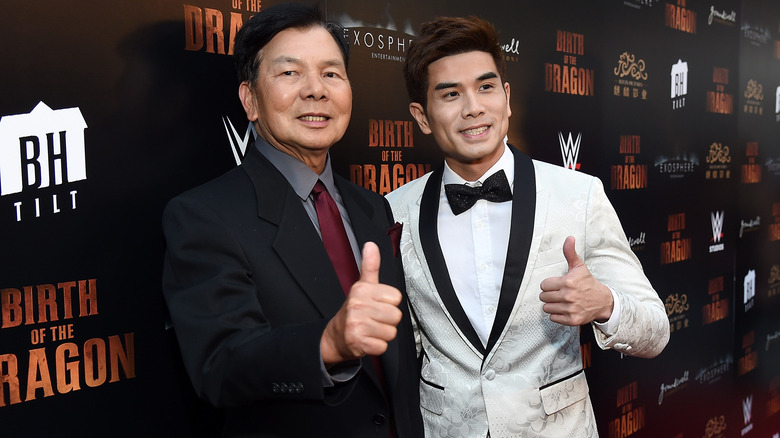The Mystery Surrounding The Fight Between Bruce Lee And Wong Jack Man
We may receive a commission on purchases made from links.
On a late autumn evening in 1964, in a former upholstery business in north Oakland that was now a martial arts studio, Bruce Lee stood in the center of the room glaring at his opponent, Wong Jack Man, according to Charles Russo's "Striking Distance: Bruce Lee and the Dawn of Martial Arts in America." The fight between these two men — both in their 20s — that was about to take place, would become cloaked in mystery, mythologized by Hollywood, and debated for years to come.
It wasn't only Hollywood that helped muddy the truth behind this private match between two young martial artists — one who would become a famous actor, the other a grand master of Northern Shaolin Kung Fu — but also the participants and the eyewitnesses at Lee's Oakland kung fu studio. Rick Wing, author of "Showdown in Oakland: The Story Behind the Wong Jack Man — Bruce Lee Fight," compared the fight to Akira Kurosawa's famous 1950 film "Rashomon," which tells its story from different viewpoints and leaves one unsure of what actually took place. One big reason for the lack of clarity is that there were only seven witnesses to the fight between Lee, a rebel pushing kung fu into the future, and Wong, a traditionalist seeking to keep the old ways alive, per Vice.
Rebel Versus Traditionalist
By the time of the fight, Bruce Lee had opened his own kung fu studio in Oakland, which at the time was a center for martial arts less tradition-bound than across the bay in San Francisco's Chinatown, per Vice. Lee practiced Wing Chung kung fu but was developing his own style that incorporated various practices and had recently put out a book, "Chinese Gung Fu: The Philosophical Art of Self-Defense," that was critical of older kung fu techniques. He was also giving demonstrations, including one in Chinatown, in which he called San Francisco's grandmasters "old tigers with no teeth" and derided traditional Chinese martial arts, Wong Jack Man told Michael Dorgan in 2017.
Wong Jack Man had recently immigrated to the U.S. from Hong Kong to reunite with his family and bring Northern Shaolin, Taijiquan, and Xingyiquan Chinese martial arts to America, per the Michael Dorgan interview. Chinatown welcomed Wong with open arms, and although he was working part-time as a waiter to help support himself, he was teaching kung fu with an eye toward starting his own school, per Bruce Lee: A Life.
The Lead-Up to the Fight
Like everything else involving this fight, there are differing versions of what led up to it. During one of Bruce Lee's demonstrations in Chinatown, he allegedly bragged that he could beat anyone in San Francisco, which was the catalyst for Wong Jack Man stepping up to defend the honor of Chinatown's traditional kung fu practitioners and take on the rebel, according to Zophia's Stone's "Bruce Lee: A Biography." Yet, in Wong Jack Man's interview with Michael Dorgan, he says Bruce Lee denied he'd issued the challenge on stage.
Bruce Lee gave a competing story of why the fight went down. He claimed that the Chinatown community told him to stop teaching non-Chinese people kung fu and that if he lost the fight, he'd have to shut down his Oakland martial arts studio, per "Bruce Lee: A Biography." While there had traditionally been a ban on teaching kung fu to non-Chinese people, by the 1960s, it was no longer in force, and some of the Chinatown teachers had white students, per Vice.
Who Really Won the Fight?
The most likely reason the fight between Bruce Lee and Wong Jack Man happened is simply that the tradition-bound Chinatown kung fu schools wanted to put Lee in his place. "What provoked the fight was Bruce Lee's arrogance and his insulting treatment of other martial artists," Wong Jack Man told Michael Dorgan. Similarly, who won the fight depends on the source.
According to Linda Lee, Bruce Lee's wife, who was present that night, the fight lasted all of three minutes. Bruce Lee began with a quick series of straight punches. Wong attempted to back up, stumbled, turned, ran, and Lee pounced on him and began pummeling him into submission, per a July 1980 article for Official Karate Magazine. David Chin, a friend of Wong's who had negotiated the match, recalled that Wong was able to block many of Lee's attacks through an open-hand windmill defense and, at one point, used his studded bracelets he'd hidden under his sleeves to bloody Lee's neck. This allegedly resulted in Lee going berserk and pounding Wong, per Matthew Polly's "Bruce Lee: A Life." Chin agreed Lee was the winner, per SFWeekly.
Wong Jack Man's Version of the Fight
In Wong Jack Man's version of the fight, Bruce Lee told him, "We are going to fight to the death," and when Wong went to shake his hand before the fight, Lee pretended to return the handshake before shooting his arm out toward Wong's eyes, his hand curved "like deadly claws," per the Michael Dorgan interview. Wong blocked the shot, but Lee ended up slicing him above the eye.
Wong claimed Lee made noises "like a ghost screaming," and he believed Lee "really wanted to kill me," per the Michal Dorgan interview. Wong said he got Lee in a headlock three times during the fight that lasted upward of 20 minutes and that he could have taken Lee out but was afraid he would seriously hurt him, per the interview. William Chen, who had come with Wong to Oakland that night, also said the fight was around 20 minutes long, according to "Bruce Lee: A Biography." In this version of events, the fight ended because Lee was too winded to continue.
Hollywood's Version of the Fight
Besides these two versions of the fight between Bruce Lee and Wong Jack Man, Hollywood has put its own spin on the story in two films, 1993s "Dragon: The Bruce Lee Story" and 2016's "Birth of the Dragon." Both play fast and loose with the truth. In the earlier film, the fight takes place in a strange dungeon-like space overseen by sinister kung fu masters, in which Wong damages Lee's spine in an underhanded move, per Vice. In "Birth of the Dragon," the fight has Wong dressed in a traditional orange Shaolin robe (he actually wore a black kung fu uniform), espousing philosophy while doing flips and trading lighting quick moves and quips before the fight ends in a draw, per the film.
Hollywood is known for its mythmaking, and it was where Bruce Lee found fame after developing his own style of kung fu, Jeet Kune Do, as a direct result of the fight, per Mental Floss. Just as Lee's star ascended, he died tragically of a cerebral edema in 1973 at age 32, just before his greatest cinematic achievement, "Enter the Dragon," came out (via per History). Wong Jack Man avoided the limelight, preferring to become a much-loved grandmaster kung fu teacher in San Francisco before his death in 2018, per Shaolin Lomita.
